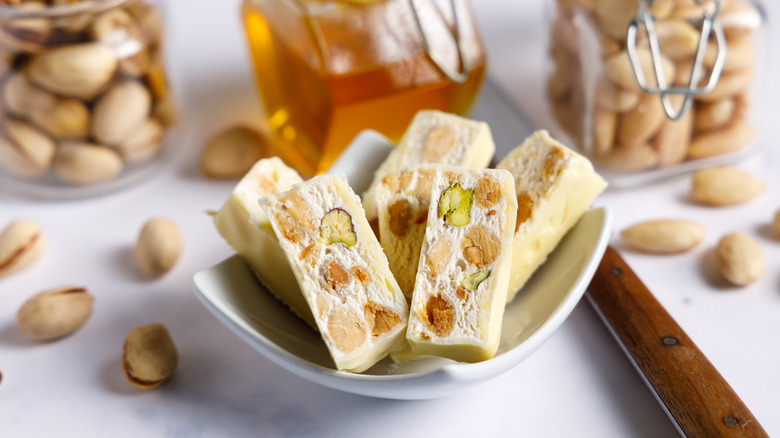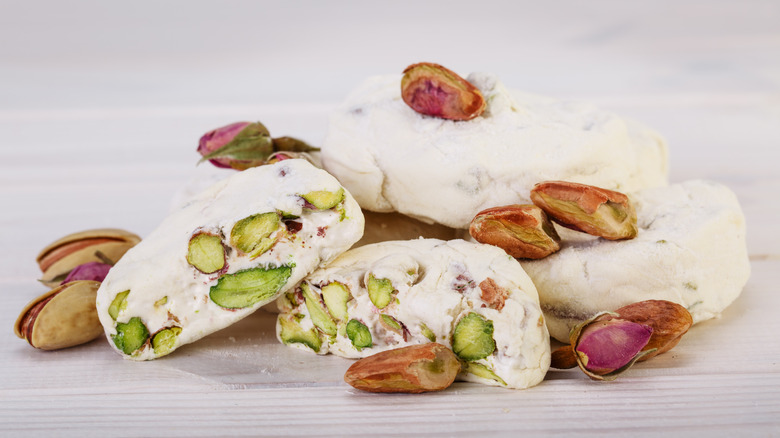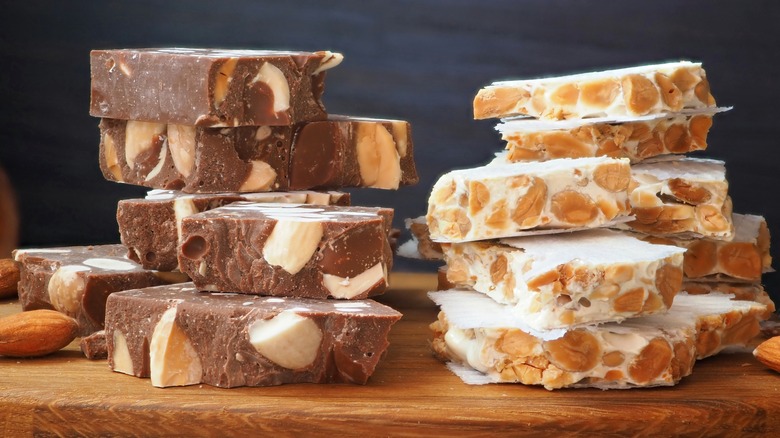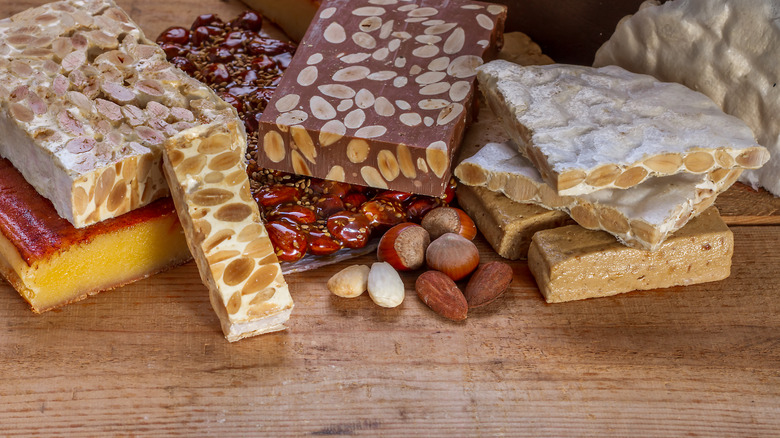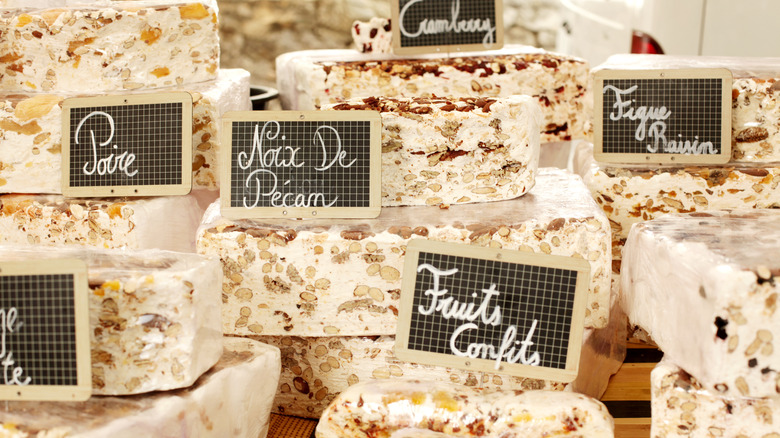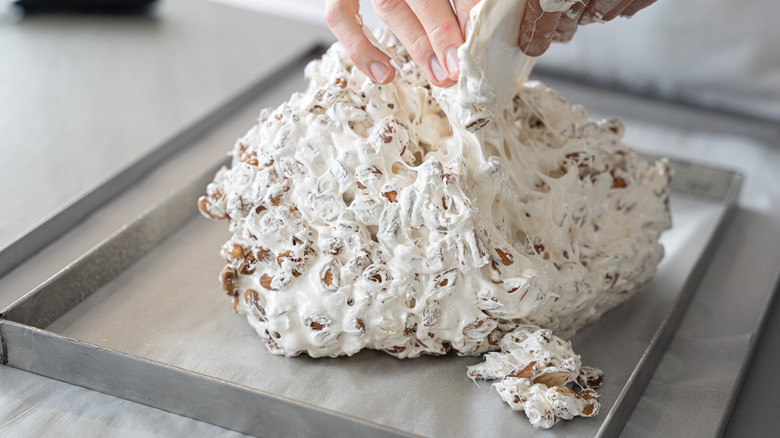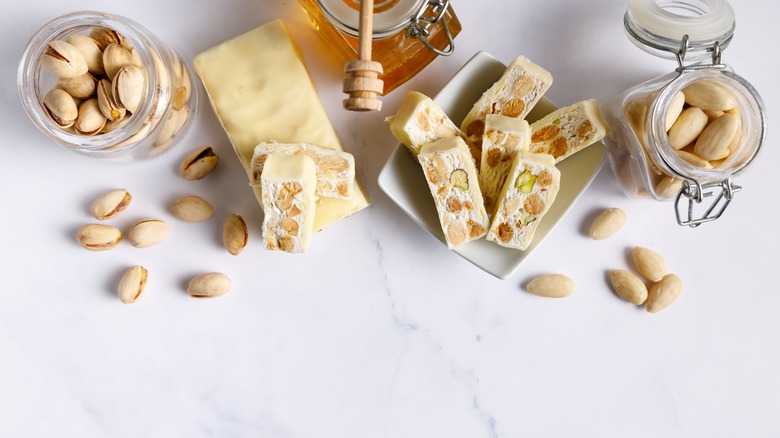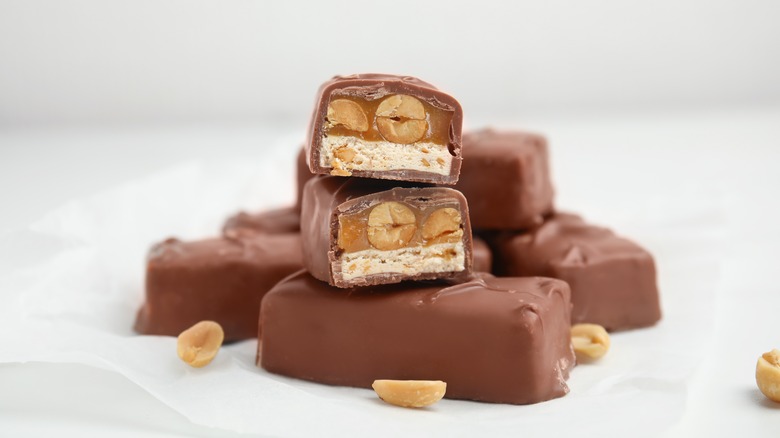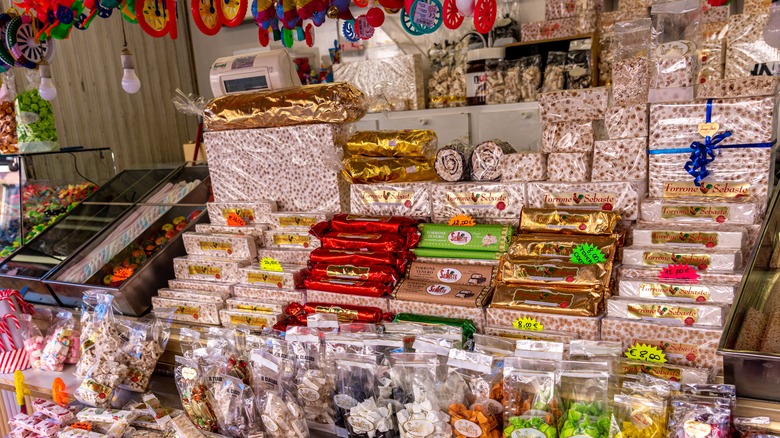What Is Nougat And How Is It Made?
Bridging the textural divide between marshmallow and meringue, nougat is a sweet and sticky candy that people have been enjoying for at least a thousand years. In Europe, especially, nougat has come to be associated with the holiday season, but it is made from ingredients accessible year-round. It isn't so easy to find on sale outside of Mediterranean countries, but most households are already equipped with the pantry staples required to make their own.
Today, nougat is often analogous with French Montélimar candy or Italian Torrone, but it's enjoyed all around the Mediterranean, where numerous cultures have created their own renditions. While variations of nougat have, in more recent history, found their way into popular candy bar brands, the mass-produced, caramel-slathered, chocolate-covered versions are a far cry from the traditional nougat that combines timeless flavors into textural marvels. Served in the form of bars or cut into cubes, and sometimes even sliced like cake, traditional nougat is reliably sweet, nutty, chewy, and simultaneously light and decadent.
Nougat has ancient Mediterranean origins
Nougat has its origins around the Mediterranean, and remains most popular in this region today. Comprised of ingredients such as almonds and pistachios, that are native to Persia and the Middle East, it's not so surprising that the earliest known nougat recipe can be traced back to 10th century Baghdad. Incorporating the same egg whites and honey that are still primary ingredients for nougat today, this ancient recipe called for cinnamon, cloves, hemp seeds, pistachios, almonds, and dried coconut to be mixed into the nougat base.
During the Middle Ages, nougat's popularity moved west with Arab influence. Reaching Spain and Italy in the 1400s, nougat was a mixture of ingredients — honey, almonds, and spices — that had already become important in Spanish and Italian cuisine. In the 1600s, nougat eventually reached France, where it became so popular in Southern French cuisine that it is today a local staple.
Fusing into many cultures, nougat is an overarching type of sweet that has taken on many different appellations. According to the Dictionary of Food and Drink, this age-old treat was not officially known as "nougat" until 1827, when the name first appeared in a book of Italian cookery. A sweet that has been enjoyed for centuries, nougat hasn't changed much from the original recipe hundreds of years ago. Though the process to prepare it may be a bit time-consuming, the ingredients are simple and the flavors timeless.
There are two fundamentally different types
Nougat varieties can be divided into two distinct archetypes: White nougat and black nougat (sometimes called brown or dark nougat). Though the two varieties make use of the same main ingredients, their manner of preparation produces very different end results. White nougat is perhaps the better-known, with its marshmallow-like consistency and cream-colored base. Its off-white color comes from the beaten egg whites that form the foundation of a nougat batter. White nougat is cooked more slowly and stirred more frequently, and many recipes are enhanced with the addition of vanilla. White nougat can take up to five hours to cook and must be left in a mold overnight to set and take shape.
Black nougat, contrastingly, is far faster to prepare and takes much less time to set — usually only a few hours rather than overnight. Though it consists of the same ingredients as white nougat, black nougat must be stirred much more vigorously, and gets cooked only until its honey is caramelized (about 45 minutes) which grants black nougat its signature darker color and a harder texture. Nougatine, a French black nougat, is quite brittle, and therefore does not easily accommodate candied fruit, but often incorporates seeds in addition to the almonds that are traditionally mixed in with the caramelized egg white mixture. Some black nougat recipes also call for cocoa, which enhances the darker color and offers a chocolatey contrast to its white and often vanilla-forward counterpart.
Different regions have different preparation methods
Nougat is a broad descriptor and many cultures have adapted the same basic ingredients into distinct and diverse recipes. Spain and Italy have become some of the world's biggest producers of nougat, and the confection is deeply rooted in each country's culinary culture. Prepared, gifted, and enjoyed primarily during the holiday season, the Spanish and Italian takes on this dessert are largely associated with Christmas. Turrón is a Spanish nougat originating in the Maghreb in North Africa, that comes in two types. Turrón de Alicante more closely resembles white nougat, and is similarly marshmallowy, but Turrón Jijona, made from powdered almonds and honey, is golden with a more buttery texture that bridges into the realm of marzipan.
In Italy, nougat is known as torrone, and also takes on many different forms. A decadent treat for special occasions since the 15th century, torrone is commonly laced with almonds and pistachios and can also be either hard or soft. Different ingredients get mixed into torrone depending on certain regional preferences — some places incorporate hazelnuts and wafers into the egg whites, while others get spiced with cinnamon, cloves, and cocoa.
Nougat also remains a seasonal Persian confection. Gaz is a variety of nougat from Iran, that's commonly made to celebrate the New Year. Formed from the same base of egg whites, sugar, and roasted nuts, gaz is more meringue-like in consistency. It traditionally incorporates pistachios and is distinctive for being flavored with rose water.
Nougat has become a French tradition
Myths of the southern French city Montélimar as the birthplace of nougat are likely untrue, considering the sweet was proliferating in the Middle East well before it ever reached France. But nougat has become so inextricably linked with this French region's identity that it's easy to see why the myths of nougat's French origin may have started in the first place. Montélimar, located in the Drôme Provençal region with its Mediterranean climate, produces lots of honey and almonds among its local agricultural products, both of which are essential ingredients in any French nougat recipe.
Today, Montélimar is renowned for its white nougat, and the city's nougat heritage suggests that even the name for the confection comes from a French phrase. According to legend, a woman in 18th-century Montélimar was complimented for her innovative egg-white confectionery. Her friends, upon trying it, declared, "Tu nous gâtes" (You spoil us), and the treat has allegedly been known as "nougat" ever since.
Even though the nougat recipe itself is not French in origin, nougat has been adopted as an important treat in Provençal culinary culture. Montélimar nougat is traditionally served as one of the 13 integral desserts on a Provençal Christmas table, a holiday tradition that dates back many centuries. Most of these traditional dessert spreads include both white nougat and dark nougat, intended to symbolize good and evil.
How to make nougat
Nougat is composed of simple ingredients, with a base that consists of egg whites and a sweetener. Honey and sugar are the most traditional sweeteners, though mass-produced versions often incorporate corn syrup too.
To make nougat, a few key tools are required. The process calls for a whisk (best in the form of a stand mixer attachment), a candy thermometer, and wax paper (for storage). The sugar and honey must be heated separately to a specific temperature, and once sufficiently heated and liquefied, both sweeteners get added to beaten egg whites. All of this is whipped together quickly into a mixture that's stiff, full of air, and double in size from the original mixture. It's important not to over-whip the egg whites — this will make them start to separate, with liquid pooling in the mixture, ruining the final texture. Lastly, roasted nuts (and dried or candied fruits) get folded into the sticky, marshmallowy mass until everything is evenly distributed.
Once ready, the mixture gets poured into a pan and must be left to set for many hours. Some recipes call for as few as two hours, but overnight is preferable. If making nougat at home, it's a good idea to pour it into a pan lined with wax paper, as the batter is very sticky. When cutting the nougat, it's also helpful to use a greased knife, preferably a serrated chef's knife, as the sticky texture is not otherwise the most conducive to clean cutting.
What does nougat taste like?
Nougat varies in flavor, depending on the ingredients incorporated into the batter, but it is generally sweet and nutty all at once, thanks to the roasted nuts that get incorporated into the sweetened, whipped egg whites. Almond and pistachio are the more traditional nuts that pair particularly well with the nougat base, but hazelnuts, macadamia nuts, and walnuts are also commonly included, with each variety adding a distinct flavor to the soft, sticky batter it gets mixed into. Peanuts are not commonly found in artisanal, hand-crafted nougat, but are almost exclusively paired with other forms of nougat that are common candy bar fillings.
Overall, nougat has a flavor that's mildly marshmallowy but startlingly sweet, and is generally a very light confection. Because it's made with egg whites, nougat is low in fat content and high in sugar. Despite the extreme sweetness, it isn't terribly rich, making it dangerously easy to devour in large quantities.
Nougat texture ranges from light and soft to hard and brittle, depending on the type of nougat and the manner in which it's been prepared. Nougat sweetened mostly with honey is softer in consistency, whereas nougat made with melted sugar is harder. From borderline marshmallow-like melt-in-your-mouth softness to nearly as crisp as peanut-brittle, most nougat varieties are quite sticky, but still easy enough to chew. Any mouthful of traditional nougat is simultaneously chewy and addictively crunchy.
Its many forms in popular candy bars
While nougat as a standalone treat may not be as popular or accessible in the United States, the confection has proliferated in a different form. Across the Atlantic, nougat is regarded less as a treat to be enjoyed on its own and is rather most commonly found as a candy bar filling. Nougat makes up the bulk of many well-known, chocolate-covered candy classics. Snickers, Three Muskateers, Baby Ruth, Milky Way, Charleston Chews, and Mars bars all incorporate nougat among their central ingredients. Some of these brands originally capitalized on nougat for purely economic reasons — the earliest versions of the Milky Way bar, for example, were filled mostly with nougat because it was cheaper to mass produce than caramel. Today, nougat remains a candy bar filling that may often be overshadowed by the bolder flavors of caramel, peanuts, and chocolate which define these decadent flavor profiles.
Nougat is also popularly found in more artisanal chocolates. Amongst its confections, See's Candies offers a Dark Almond Nougat, featuring dark chocolate with a nougat filling. Toblerone's signature bar contrastingly pairs Swiss milk chocolate with honey and almond nougat. Whether or not nougat as a candy filling is able to shine through with a distinct flavor, it contributes some of the signature chewy texture that has made each of these candies so popular.
Where to find nougat
Without easy access to regional markets or artisanal confectioners, traditional nougat on its own can be harder to find outside of Europe and the Middle East. Even today, nougat is still largely made by artisan producers who supply a highly localized demand. But in this interconnected day and age, it's possible to order nougat online through various manufacturers. Torrone Candy, a Vermont-based company that specializes in Italian nougat, ships their products internationally. Andy Anand is another American chocolatier that also ships internationally — though it offers local pickup too, for customers in Los Angeles. This brand offers an especially wide array of innovative nougat flavors, including macaron-filled nougat or coffee-flavored nougat dotted with roasted espresso beans. Additionally, there is a selection of Amazon vendors that offer varieties of nougat for purchase.
For brick-and-mortar possibilities, World Market retailers occasionally have bars of nougat amongst their international treats. But you'll probably have more luck at an Italian or Middle Eastern market, where bars of Torrone or Gaz are more likely to be readily available. If nougat proves too difficult to find in stores, it's fortunately something that anyone can make at home. While the cooking process may require a bit of finesse, the baseline ingredients are pantry staples. So long as there are eggs, sugar, and honey in the kitchen, anyone can make nougat when the craving strikes.
